Evaluation of Distribution Properties of Non-Point Source Pollution in a Subtropical Monsoon Watershed by a Hydrological Model with a Modified Runoff Module
Abstract
:1. Introduction
2. Model and Methods
2.1. The Modification of the Hydrological Model
2.2. Establishment of Databases
2.3. Delineation of Sub-Basins and the Hydrologic Response Unit
2.4. Calibration and Validation
2.5. The NPS Generation Potential Parameter
2.6. The Theory of Filter Strips for NPS Control
3. Results and Discussion
3.1. Results of Simulations with the Model
3.1.1. Parameter Sensitivity Analysis
3.1.2. The Comparison of SWAT and SWAT-m
3.1.3. Results of Simulations with the Modified Model
3.2. Temporal and Spatial Distribution of NPS
3.2.1. Temporal Distribution
3.2.2. Spatial Distribution of NPS
3.3. Analysis of the Generation Potential of NPS
3.3.1. NPS Generation with Topography
3.3.2. Accurate Positioning of NPS CSAs
3.3.3. The Main NPS Pollutants in Sub-Basins
3.3.4. Temporal Distribution of NPS CSAs
3.4. NPS Control Management
3.4.1. Scenario
3.4.2. Simulation and Best Selection
4. Conclusions
Author Contributions
Funding
Acknowledgments
Conflicts of Interest
References
- Lee, S.I. Nonpoint source pollution. Fisheries 1979, 2, 50–52. [Google Scholar]
- Di, L.M.; Arnold, J.G. Formulation of a hybrid calibration approach for a physically based distributed model with NEXRAD data input. J. Hydrol. 2004, 298, 136–154. [Google Scholar]
- Deslandes, J.; Michaud, A.; Bonn, F. Use of GIS and remote sensing to develop indicators of phosphorus non-point source pollution in the Pike River basin. In Lake Champlain: Partnerships and Research in the New Millennium; Springer US: New York NY, USA, 2004; pp. 271–290. [Google Scholar]
- Sumant, D.; Surinder, K.; Nilanchal, P. Hydrological modeling in middle Narmada Basin, India using SWAT model; Lap Lambert Academic Publishing: Saarbrücken, Germany, 2015. [Google Scholar]
- Hu, X.; McIsaac, G.F.; David, M.B.; Louwers, C.A.L. Modeling riverine nitrate export from an east-central Illinois watershed using SWAT. J. Environ. Qual. 2007, 36, 996–1005. [Google Scholar] [CrossRef]
- Akhavan, S.; Abedi-Koupai, J.; Mousavi, S.F.; Afyuni, M.; Eslamian, S.S. Application of SWAT model to investigate nitrate leaching in Hamadan–Bahar Watershed, Iran. Agric. Ecosyst. Environ. 2010, 139, 675–688. [Google Scholar] [CrossRef]
- Santhi, C.; Srinivasan, R.; Arnold, J.; Williams, J. A modeling approach to evaluate the impacts of water quality management plans implemented in a watershed in Texas. Environ. Model. Softw. 2006, 21, 1141–1157. [Google Scholar] [CrossRef]
- Song, L.X.; Liu, P. Study on Agricultural Non-point Source Pollution Based on SWAT. Environ. Mater. Environ. Manag. 2010, 113–116, 390–394. [Google Scholar] [CrossRef]
- Choi, W. Catchment-scale hydrological response to climate-landuse combined scenarios: A case study for the Kishwaukee River Basin, Illinois. Phys. Geogr. 2008, 29, 79–99. [Google Scholar] [CrossRef]
- Du, J.; Qian, L.; Rui, H.; Zuo, T.; Zheng, D.; Xu, Y.; Xu, C.Y. Assessing the effects of urbanization on annual runoff and flood events using an integrated hydrological modeling system for Qinhuai River basin, China. J. Hydrol. 2012, 4, 127–139. [Google Scholar] [CrossRef]
- Wilson, C.O.; Weng, Q. Simulating the impacts of future land use and climate changes on surface water quality in the Des Plaines River watershed, Chicago Metropolitan Statistical Area, Illinois. Sci. Total Environ. 2011, 409, 4387–4405. [Google Scholar] [CrossRef]
- Chung, E.; Park, K.; Lee, K.S. The relative impacts of climate change and urbanization on the hydrologic response of a Korean urban watershed. Hydrol. Process. 2011, 25, 544–560. [Google Scholar] [CrossRef]
- Cuo, L.; Lettenmaier, D.P.; Alberti, M.; Richey, J.E. Effects of a century of land cover and climate change on the hydrology of the Puget Sound basin. Hydrol. Process. 2009, 23, 907–933. [Google Scholar] [CrossRef]
- Zhang, P.; Liu, Y.H.; Pan, Y.; Yu, Z.R. Land use pattern optimization based on CLUE-S and SWAT models for agricultural non-point source pollution control. Math. Comput. Model. 2013, 58, 588–595. [Google Scholar] [CrossRef]
- Mishra, S.K.; Singh, V.P. Validity and extension of the SCS-CN method for computing infiltration and rainfall-excess rates. Hydrol. Process. 2004, 18, 3323–3345. [Google Scholar] [CrossRef]
- Nagarajan, N.; Poongothai, S. Spatial Mapping of Runoff from a Watershed Using SCS-CN Method with Remote Sensing and GIS. J. Hydrol. Eng. 2012, 17, 1268–1277. [Google Scholar] [CrossRef]
- Arnold, J.G.; Kiniry, J.R.; Srinivasan, R.; Williams, J.R.; Haney, E.B.; Neitsch, S.L. Soil and Water Assessment Tool Input/Output File Documentation Version 2009; Texas Water Resources Institute Technical Report No. 365[R]; Texas A&M University System College Station: College Station, TX, USA, 2011. [Google Scholar]
- Neitsch, S.L.; Arnold, J.G.; Kiniry, J.R.; Williams, J.R. Soil and Water Assessment Tool Theoretical Documentation (Mannual); Blackland Research Center, Texas Agricultural Experiment Station and Grassland, Soil and Water Research Laboratory: Temple, TX, USA, 2005. [Google Scholar]
- Brown, L.C.; Barnwell, T.O. The Enhanced Stream Water Quality Models QUAL2E and QUAL2E-UNCAS: Documentation and User Model; USEPA: Athens, GA, USA, 1987. [Google Scholar]
- Mishra, S.K.; Sahu, R.K.; Eldho, T.I. An improved I-a-S relation incorporating antecedent moisture in SCS-CN methodology. Water Resour. Manag. 2006, 20, 643–660. [Google Scholar] [CrossRef]
- Woodward, D.E.; Hawkins, R.H. Runoff Curve Number Method: Examination of the Initial Abstraction Ratio; World Water and Environmental Resources Congress: Pennsylvania, PA, USA, 2003. [Google Scholar]
- International Scientific Data Service Platform. Available online: http://datamirror.csdb.cn/index.jsp (accessed on 10 May 2019).
- National Earth System Science Data Sharing Infrastructure Website. Available online: http://www.geodata.cn/ (accessed on 10 May 2019).
- Guangdong Soil Survey Office. Guangdong Soil; Beijing Science Press: Beijing, China, 1993. [Google Scholar]
- Soil Science, Chinese Academy of Science Website. Available online: http://www.soil.csdb.cn/ (accessed on 10 May 2019).
- China Meteorological Science Data Sharing Service Network. Available online: https://data.cma.cn/data/detail/ (accessed on 10 May 2019).
- Basnyat, P.; Teeter, L.D.; Lockaby, B.G.; Flynn, K.M. The use of remote sensing and GIS in watershed level analyses of non-point source pollution problems. For. Ecol. Manag. 2000, 128, 65–73. [Google Scholar] [CrossRef]
- Cibin, R.; Chaubey, I.; Engel, B. Simulated watershed scale impacts of corn stover removal for biofuel on hydrology and water quality. Hydrol. Process. 2012, 26, 1629–1641. [Google Scholar] [CrossRef]
- Moriasi, D.; Arnold, J.; Van, L.M.; Bingner, R.; Harmel, R.; Veith, T. Model evaluation guidelines for systematic quantification of accuracy in watershed simulations. Trans. ASABE 2007, 50, 885–900. [Google Scholar] [CrossRef]
- Neitsch, S.L.; Arnold, J.G.; Kiniry, J.R.; Williams, J.R.; King, K.W. Soil and Water Assessment Tool Theoretical Documentation Version 2000; Texas Water Resources Institute: College Station, TX, USA, 2002. [Google Scholar]
- Abbaspour, K.C.; Vejdani, M.; Haghighat, S. SWAT-CUP Calibration and Uncertainty Programs for SWAT. In Proceedings of the International Congress on Modelling & Simulation Land Water & Environmental Management Integrated Systems for Sustainability, Christchurch, New Zealand, 10–13 December 2007. [Google Scholar]
- Hao, F.H.; Cheng, H.G.; Yang, S.T. Non-Point Source Pollution Model: Theoretical Method and Application; Chinese Environmental Science Press: Beijing, China, 2006. [Google Scholar]
- Jiang, J.; Li, S.; Hu, J. A modeling approach to evaluating the impacts of policy-induced land management practices on non-point source pollution: A case study of the Liuxi River watershed, China. Agric. Water Manag. 2014, 131, 1–16. [Google Scholar] [CrossRef]
- Ouyang, W.; Wang, X.L.; Hao, F.H.; Srinivasan, R. Temporal-spatial dynamics of vegetation variation on non-point source nutrient pollution. Ecol. Model. 2009, 220, 2702–2713. [Google Scholar] [CrossRef]
- Lee, M.; Park, G.; Park, M.; Park, J.; Lee, J.; Kim, S. Evaluation of non-point source pollution reduction by applying Best Management Practices using a SWAT model and QuickBird high resolution satellite imagery. J. Environ. Sci. 2010, 22, 826–833. [Google Scholar] [CrossRef]
- Dennis, L.C.; Peter, J.V.; Keith, I. Modeling non-point source pollution in vadose zone with GIS. Environ. Sci. Technol. 1997, 8, 2157–2175. [Google Scholar]
- Liu, Y.; Bralts, F.V.; Engel, A.B. Evaluating the effectiveness of management practices on hydrology and water quality at watershed scale with a rainfall-runoff model. Sci. Total Environ. 2015, 511, 298–308. [Google Scholar] [CrossRef]
- Schaffner, M.; Bader, H.P.; Scheidegger, R. Modeling the contribution of point sources and non-point sources to Thachin River water pollution. Sci. Total Environ. 2009, 407, 4902–4915. [Google Scholar] [CrossRef]
- Stagge, J.H.; Davis, A.P.; Jamil, E.; Kim, H. Performance of grass swales for improving water quality from highway runoff. Water Res. 2012, 46, 6731–6742. [Google Scholar] [CrossRef]
- Gorsevski, P.V.; Boll, J.; Gomezdelcampo, E.; Brooks, E.S. Dynamic riparian buffer widths from potential non-point source pollution areas in forested watersheds. For. Ecol. Manag. 2008, 256, 664–673. [Google Scholar] [CrossRef]
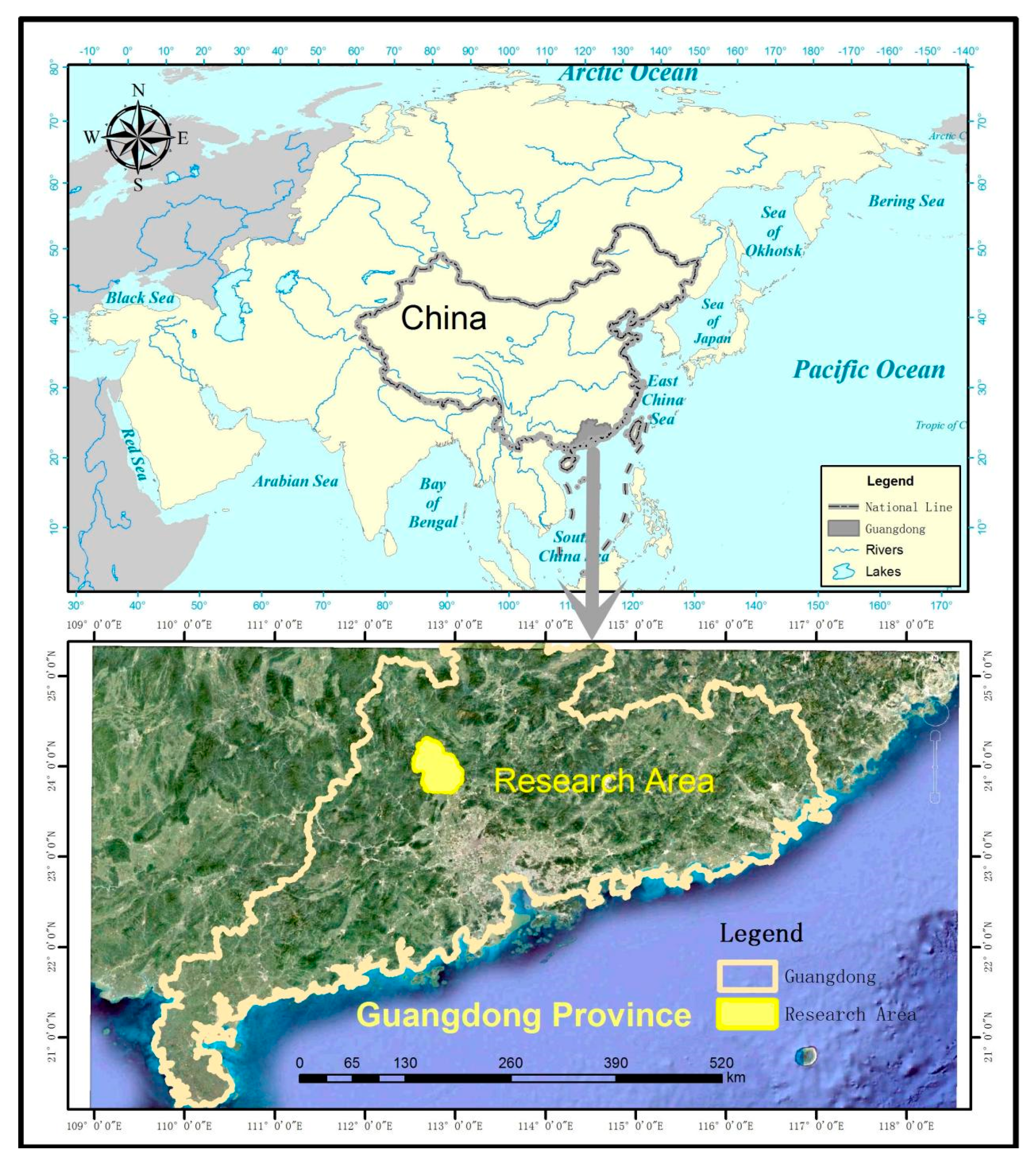
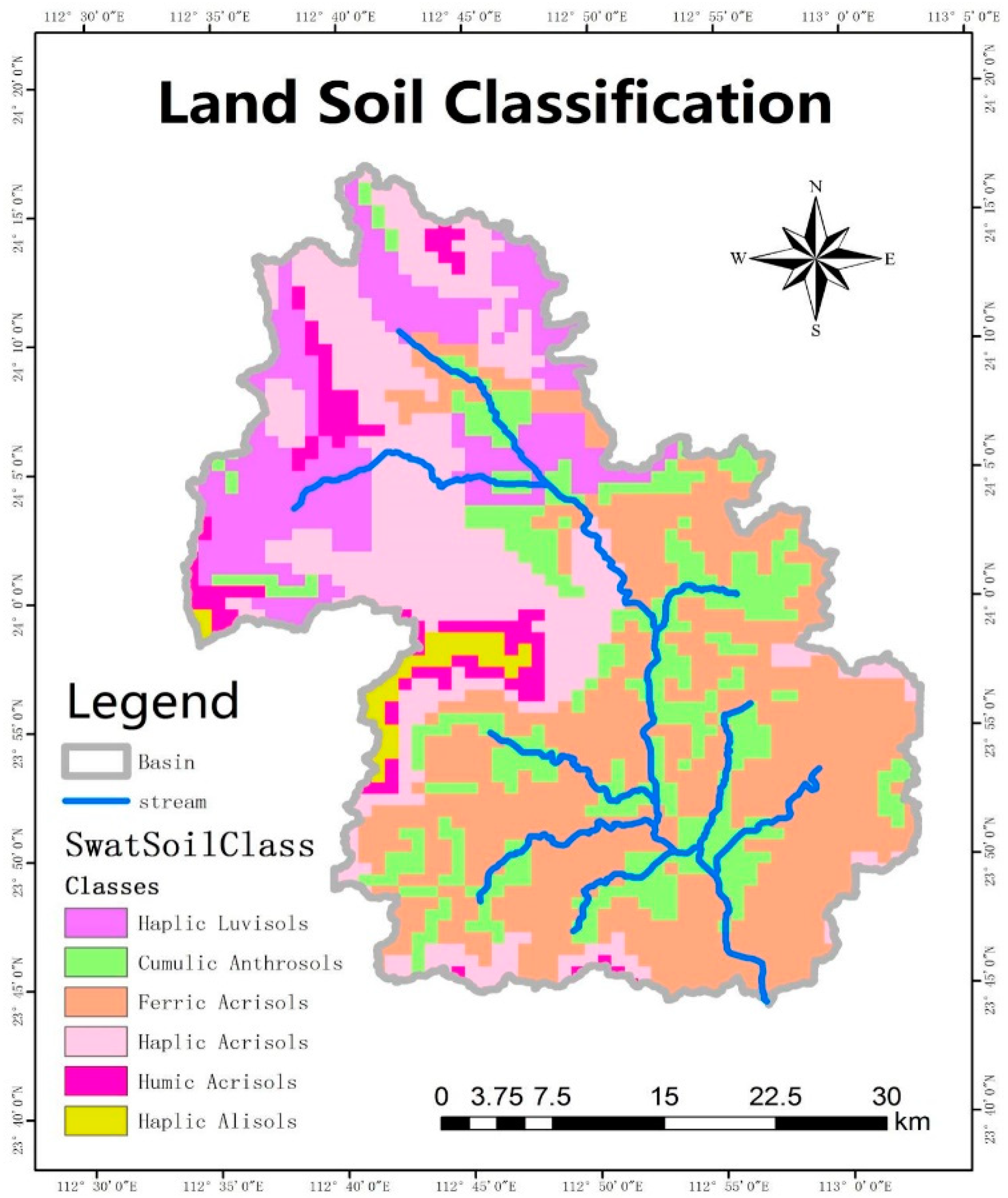
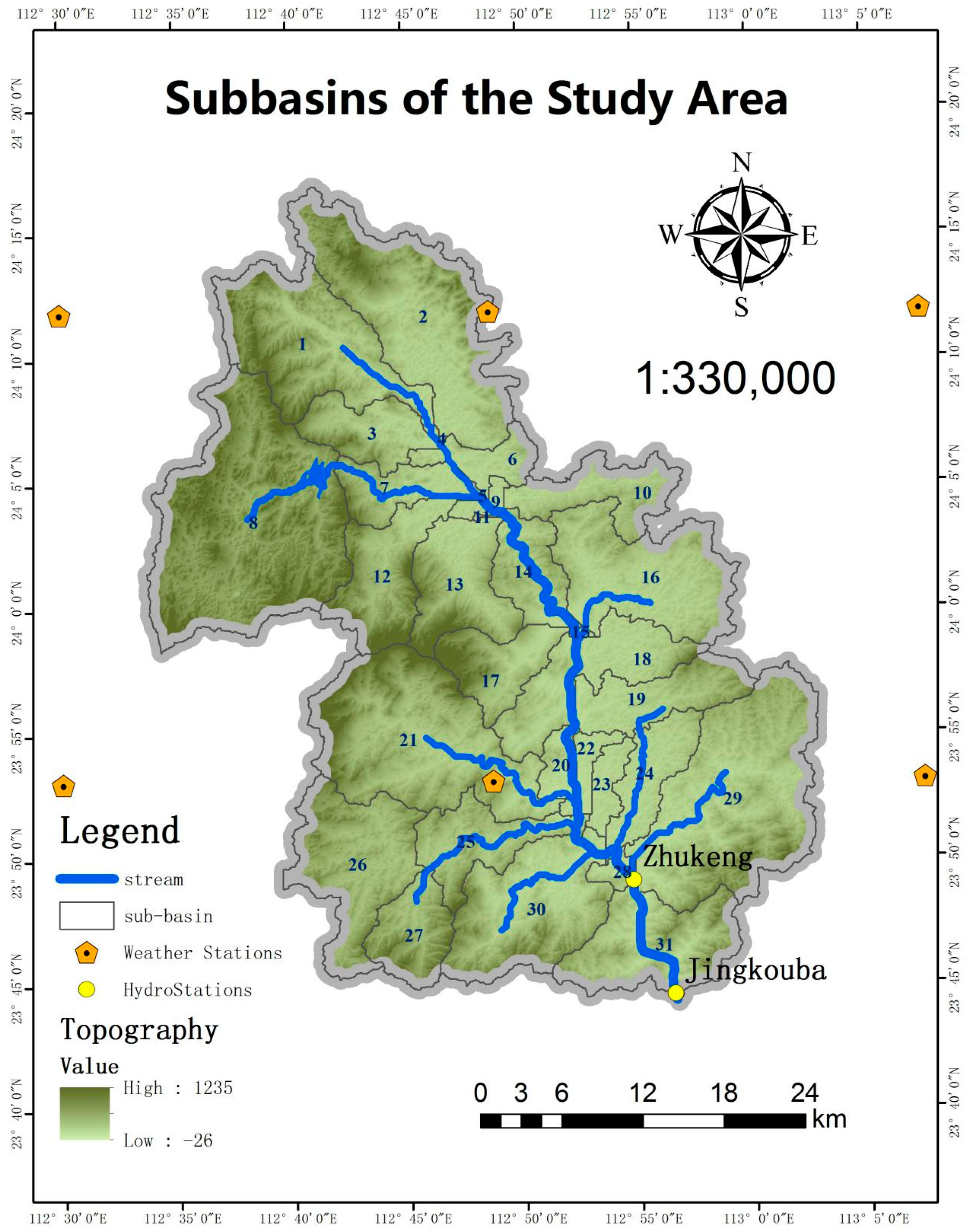
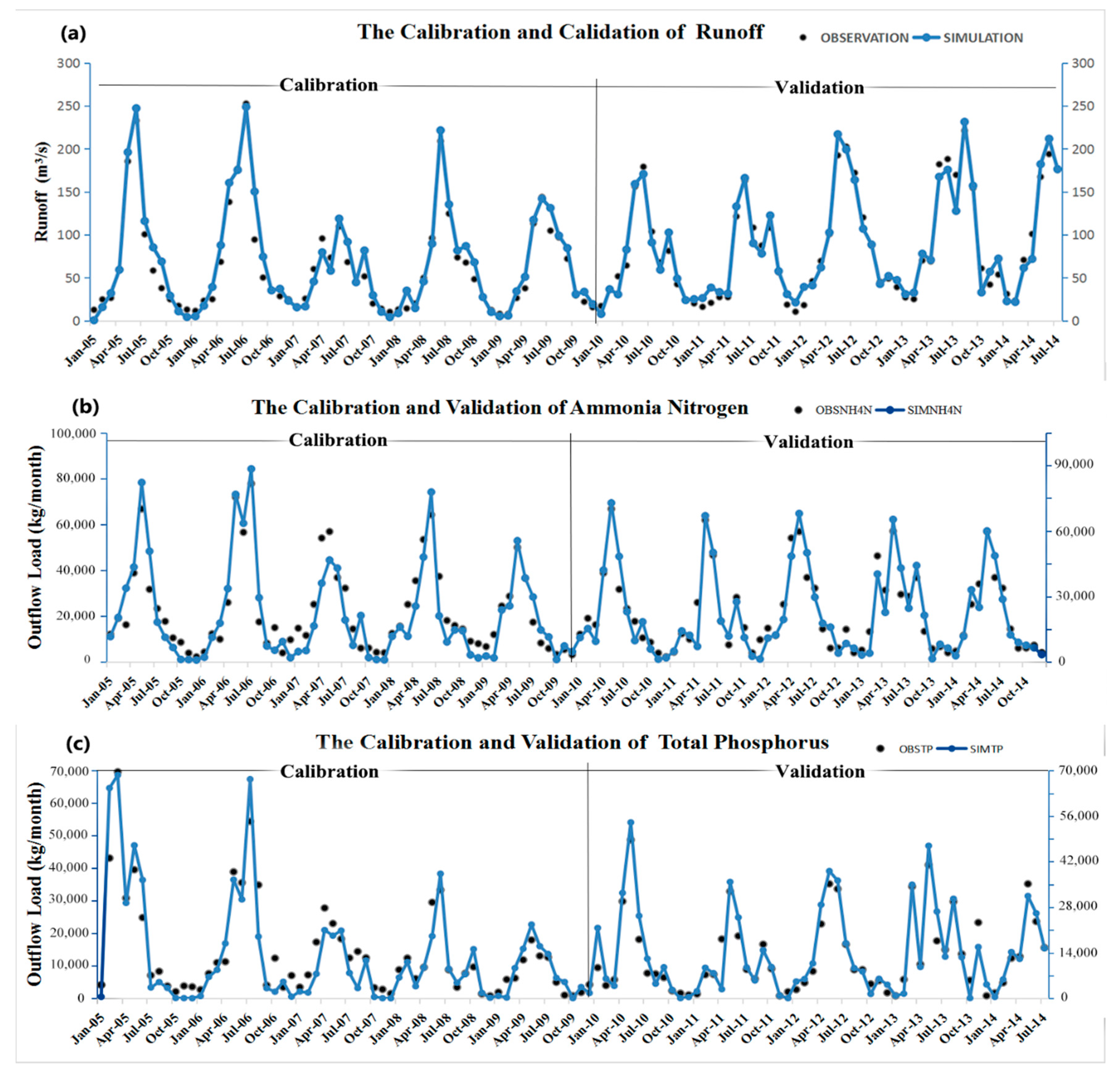
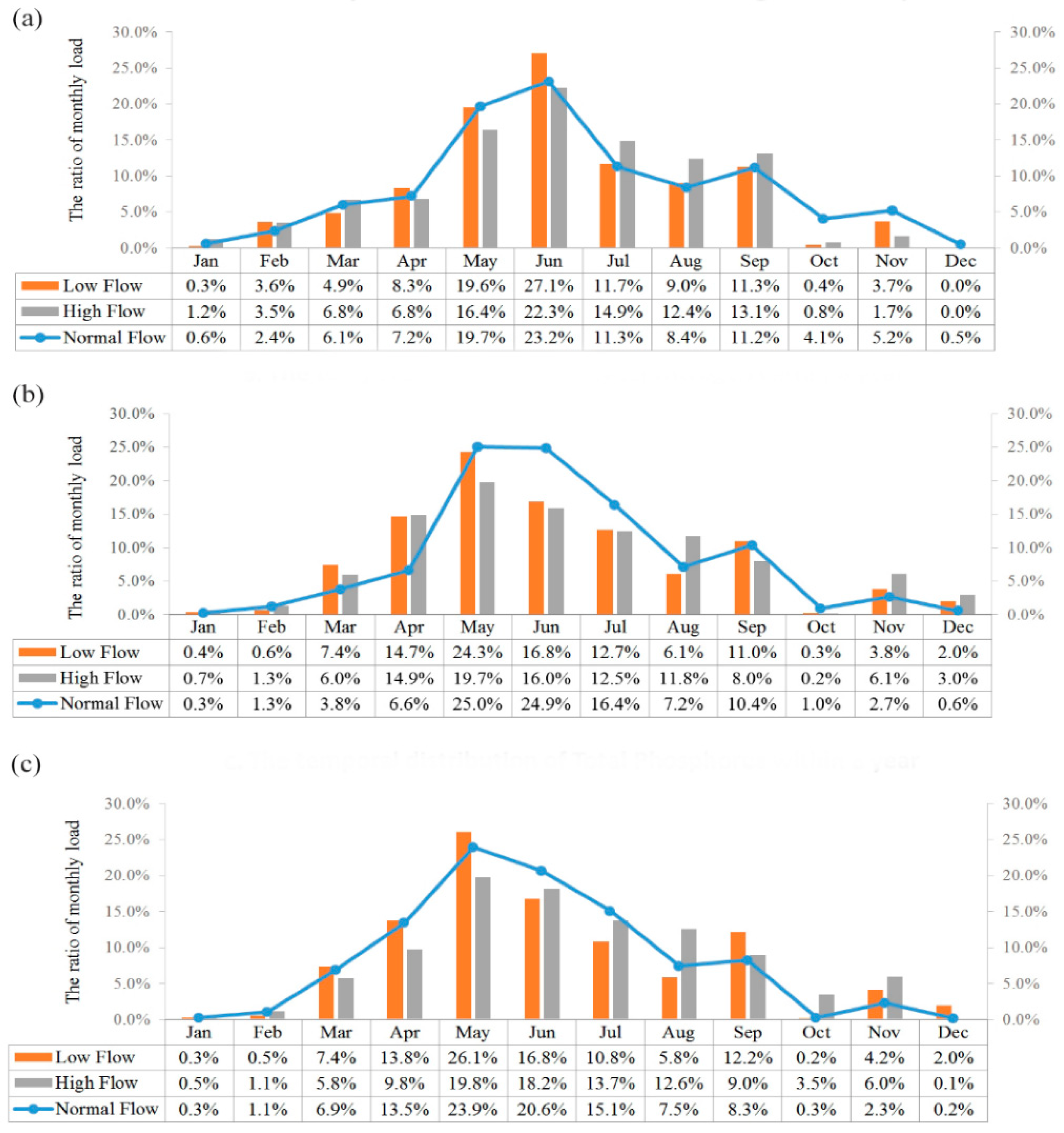
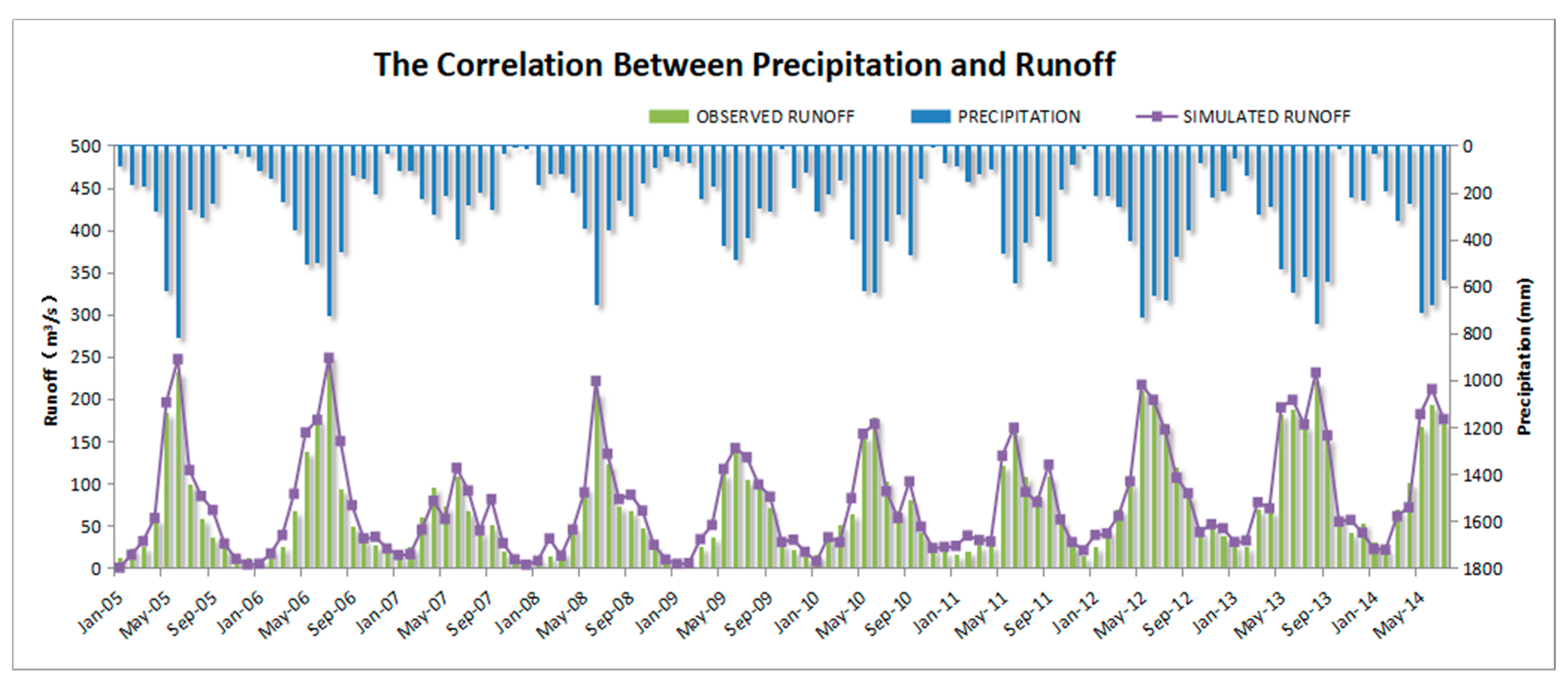
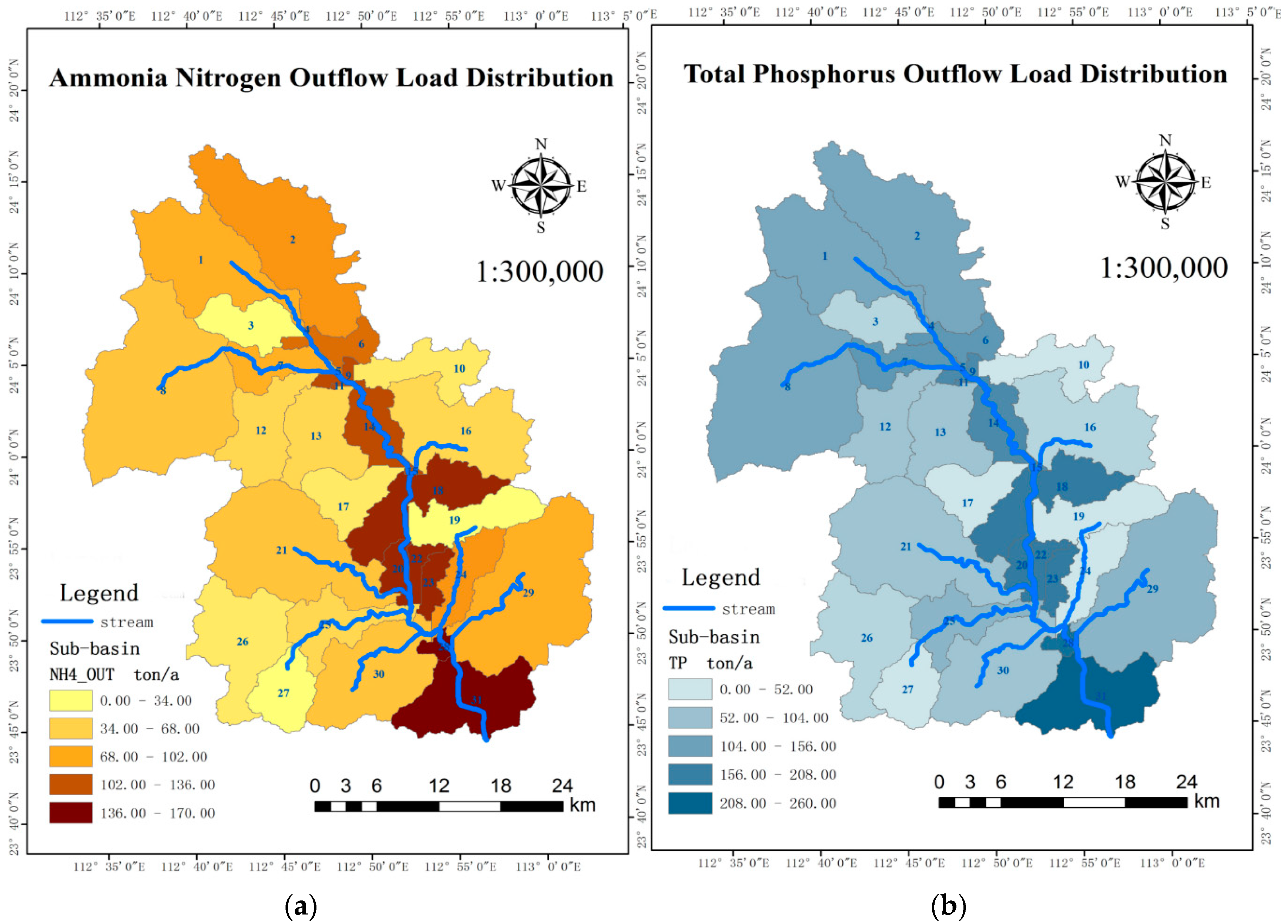
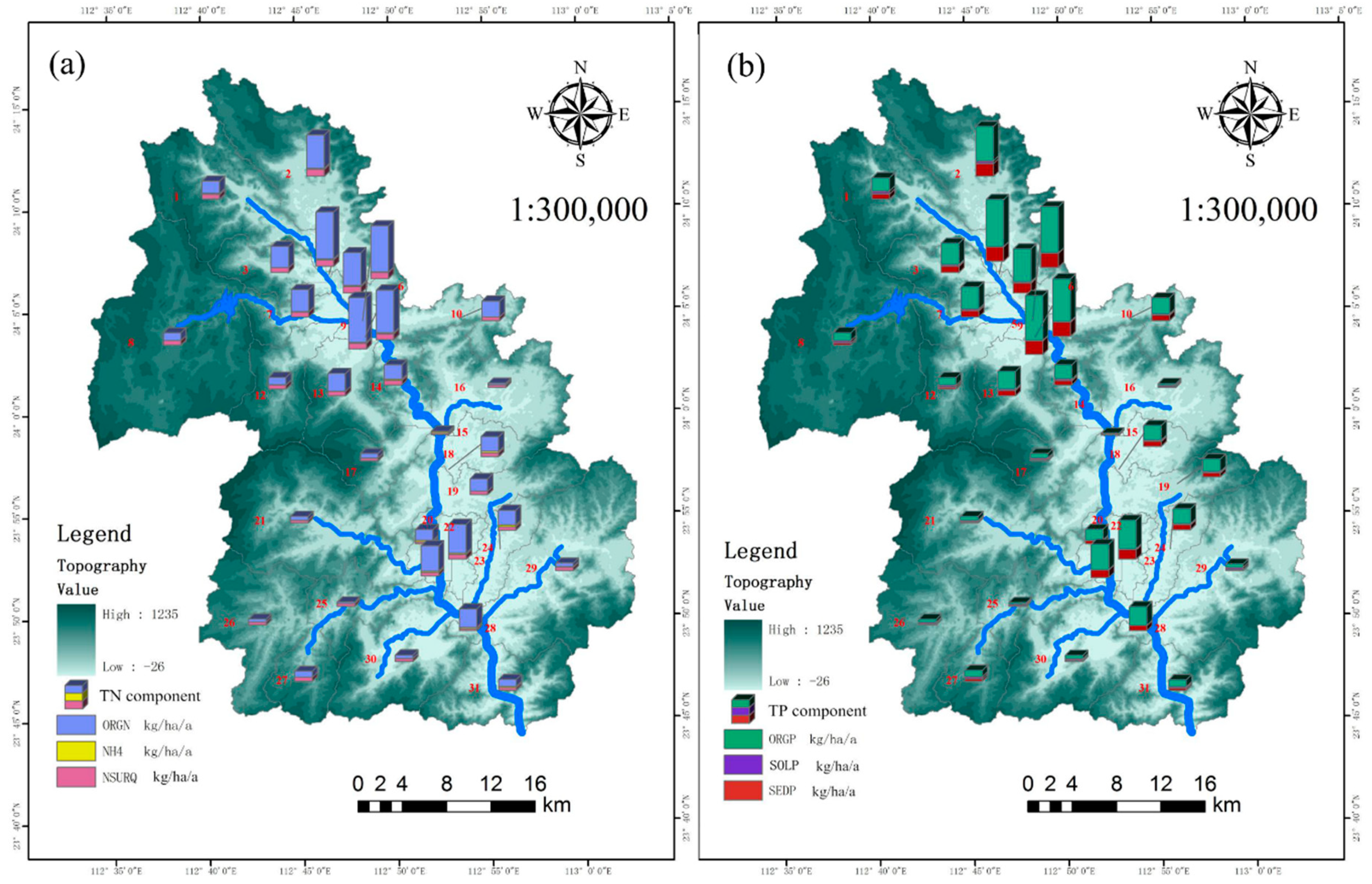
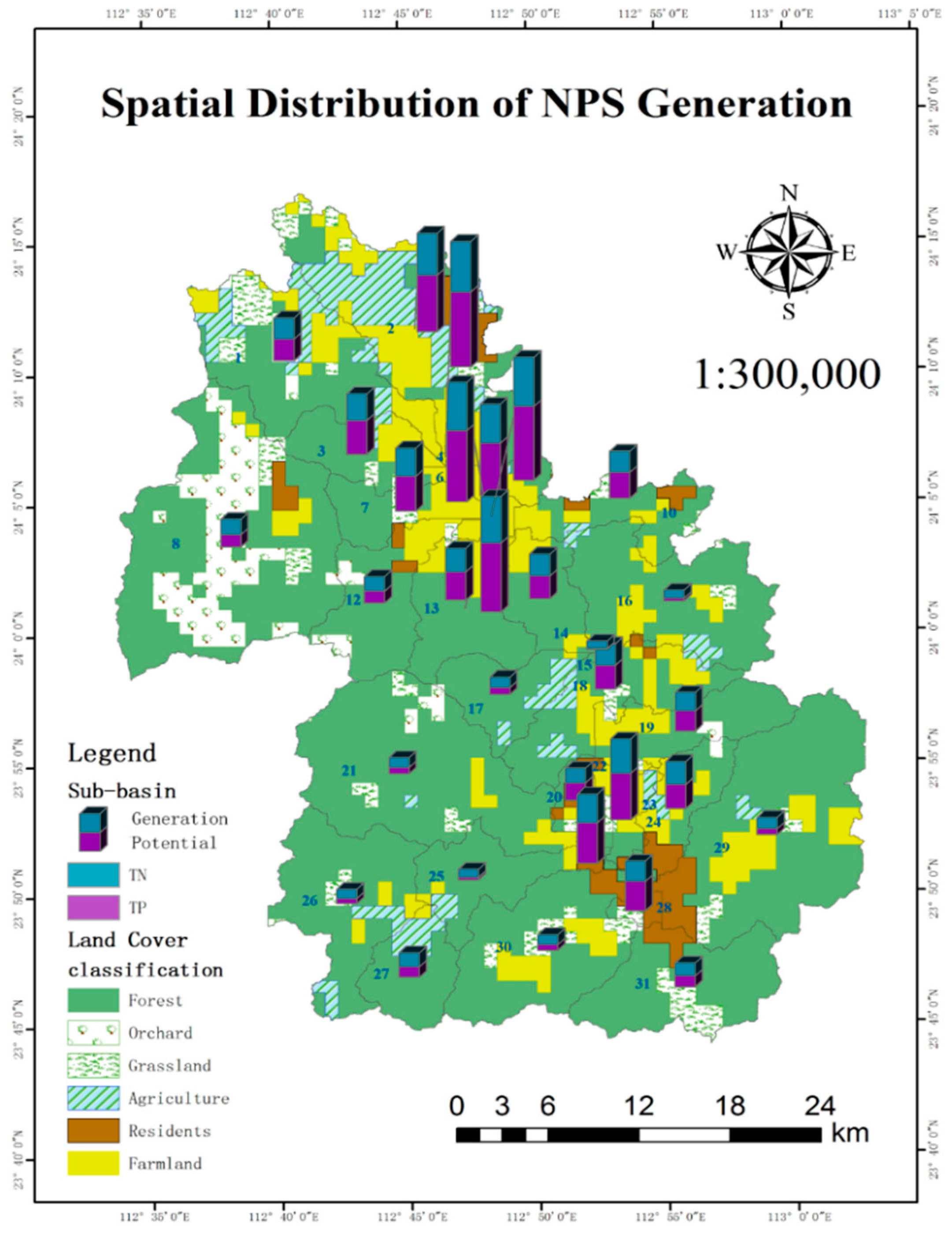
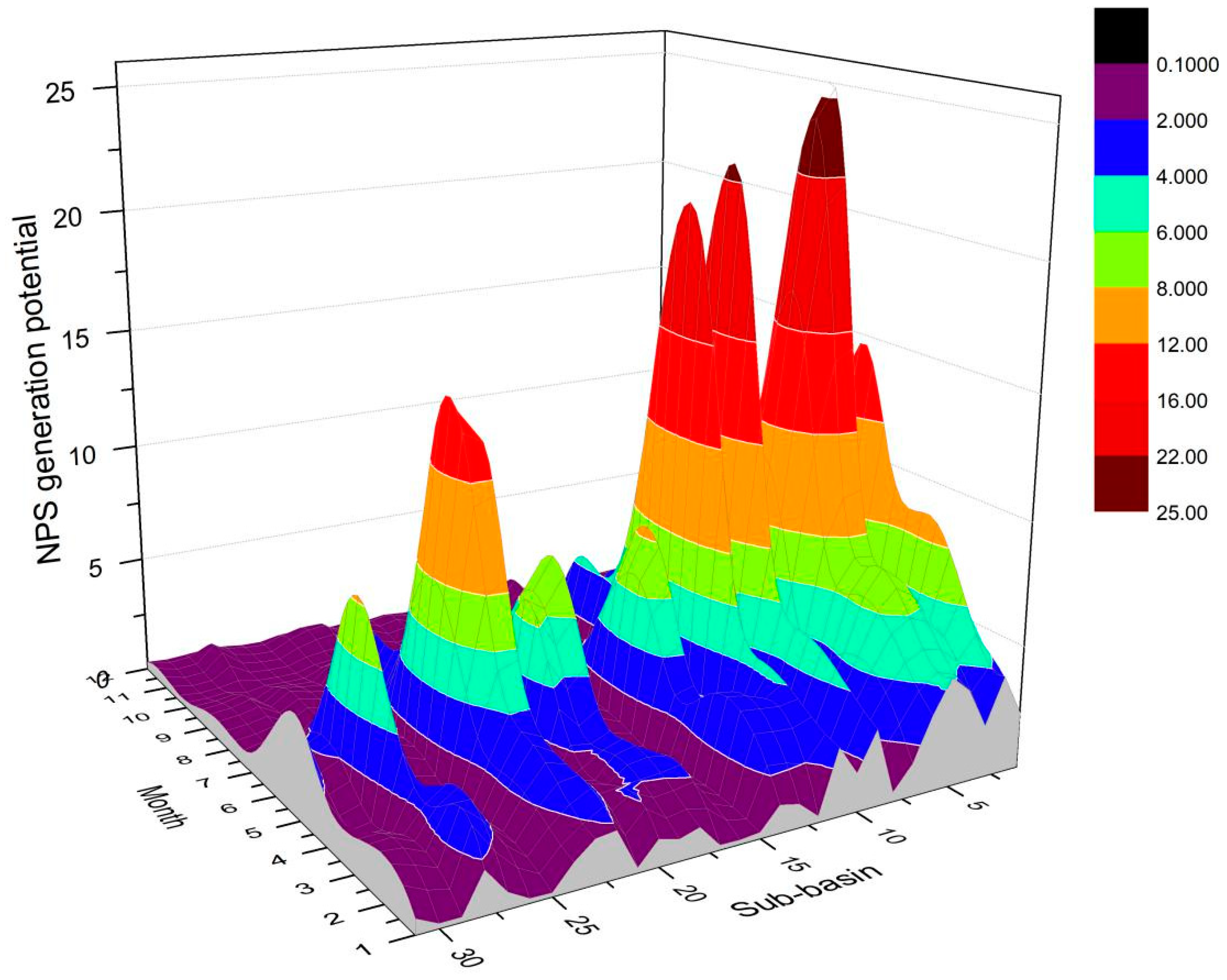
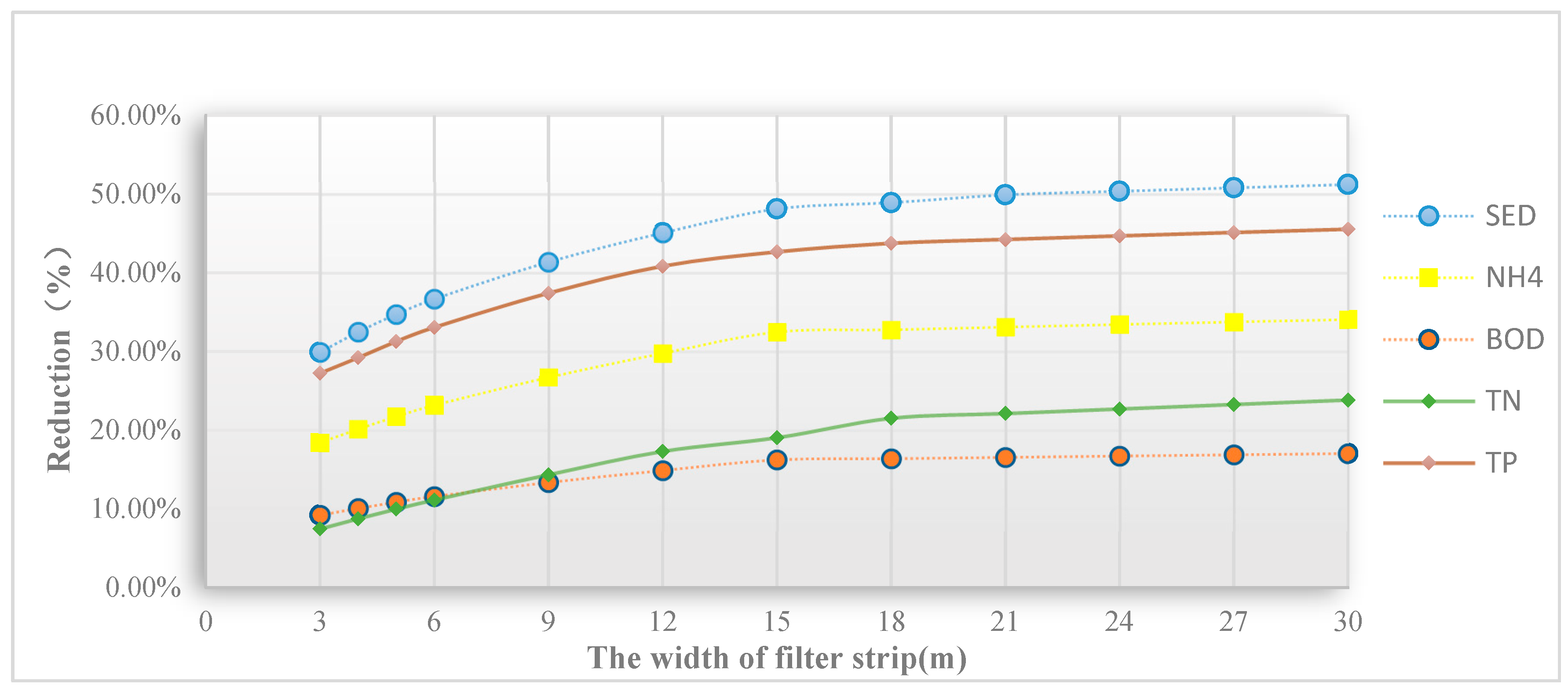
| Classification | Land Use Code | Area (km2) | Percentage (%) | Details |
|---|---|---|---|---|
| Waters | WATR | 19.76 | 1.16 | streams and lakes |
| Forest | FRST | 1145.8 | 67.14 | natural and artificial forest |
| Pasture | PAST | 101.44 | 5.94 | shrub and herbaceous plants |
| Farmland | AGRL | 260.57 | 15.27 | cropland, rice paddies, and other farming activities |
| Resident | URBN | 68.25 | 4.01 | human residents |
| Agriculture | UINS | 110.67 | 6.49 | sparse woods, livestock, poultry breeding, and others |
| No | Parameter | File | p-Value | t-Stat | Details |
|---|---|---|---|---|---|
| 1 | ALPHA_BF | gw | 0.00 | 7.50 | Base flow division coefficient |
| 2 | CH_K2 | rte | 0.01 | −3.45 | River effective hydraulic conductivity coefficient |
| 3 | CANMIX | hru | 0.03 | 2.35 | Canopy maximum water storage coefficient |
| 4 | CH_N2 | rte | 0.11 | −1.65 | Main channel Manning coefficient |
| 5 | GW_DELAY | gw | 0.23 | 1.24 | Ground water delay coefficient |
| 6 | BIOMIX | mgt | 0.26 | −1.20 | Biomass mixing efficiency |
| 7 | GWQMN | gw | 0.31 | 1.00 | Threshold depth of a shallow water aquifer required for return flow to occur (mm) |
| 8 | CN2 | mgt | 0.47 | −0.75 | SCS runoff curve number |
| 9 | ESCO | hru | 0.61 | −0.55 | Soil evaporation compensation coefficient |
| 10 | SURLAG | bsn | 0.78 | 0.33 | Surface runoff delay coefficient |
| 11 | GW_REVAP | gw | 0.85 | −0.17 | Ground water “Revap” coefficient |
| 12 | EPCO | hru | 0.97 | −0.05 | Plant uptake compensation factor. |
| Accuracy Parameters | Calibration Period | Validation Period | ||||
|---|---|---|---|---|---|---|
| SWAT | SWAT-m | Improved Percentage | SWAT | SWAT-m | Improved Percentage | |
| Ens | 0.76 | 0.92 | 21.05% | 0.72 | 0.89 | 23.61% |
| R2 | 0.82 | 0.94 | 14.63% | 0.75 | 0.91 | 21.33% |
| Re | 18% | 10% | 44.44% | 27% | 14% | 48.15% |
| SUB No. | AREA km2 | ORGN | NH4 | NSURQ | TN | ORGP | SOLP | SEDP | TP | TN + TP |
|---|---|---|---|---|---|---|---|---|---|---|
| 4 | 0.333 | 4.298 | 2.010 | 1.646 | 3.321 | 4.219 | 0.231 | 4.027 | 3.706 | 7.028 |
| 5 | 0.405 | 4.227 | 0.756 | 1.618 | 3.235 | 4.150 | 0.227 | 4.002 | 3.654 | 6.890 |
| 9 | 6.598 | 4.103 | 2.053 | 1.429 | 3.169 | 4.027 | 0.265 | 3.791 | 3.532 | 6.700 |
| 11 | 0.586 | 3.902 | 1.933 | 1.533 | 3.016 | 3.829 | 0.410 | 3.990 | 3.459 | 6.475 |
| 2 | 140.010 | 3.041 | 2.150 | 1.814 | 2.519 | 3.097 | 1.454 | 3.572 | 3.004 | 5.523 |
| 6 | 22.206 | 3.013 | 2.067 | 1.696 | 2.476 | 2.960 | 0.713 | 2.790 | 2.658 | 5.134 |
| 23 | 13.611 | 2.634 | 2.408 | 1.243 | 2.178 | 2.584 | 0.498 | 2.658 | 2.353 | 4.532 |
| 22 | 11.359 | 2.330 | 2.503 | 0.869 | 1.863 | 2.295 | 0.181 | 2.184 | 2.022 | 3.885 |
| 7 | 31.789 | 2.017 | 0.767 | 1.297 | 1.716 | 1.990 | 0.957 | 1.772 | 1.821 | 3.537 |
| 3 | 37.105 | 1.946 | 0.039 | 1.247 | 1.630 | 1.919 | 0.833 | 1.746 | 1.754 | 3.384 |
| 13 | 56.975 | 1.622 | 0.467 | 1.128 | 1.422 | 1.596 | 0.812 | 1.476 | 1.478 | 2.900 |
| 28 | 6.957 | 1.705 | 2.529 | 0.486 | 1.340 | 1.695 | 0.098 | 1.450 | 1.454 | 2.794 |
| 10 | 41.917 | 1.451 | 0.157 | 0.956 | 1.267 | 1.427 | 0.689 | 1.553 | 1.366 | 2.633 |
| 24 | 36.875 | 1.365 | 3.213 | 0.868 | 1.370 | 1.340 | 0.588 | 1.377 | 1.259 | 2.629 |
| 18 | 64.044 | 1.339 | 2.642 | 0.977 | 1.281 | 1.315 | 0.715 | 1.370 | 1.256 | 2.537 |
| 14 | 36.256 | 1.299 | 2.460 | 1.182 | 1.274 | 1.278 | 0.912 | 1.209 | 1.220 | 2.494 |
| 1 | 105.800 | 1.132 | 1.770 | 1.196 | 1.124 | 1.190 | 1.576 | 1.409 | 1.282 | 2.406 |
| 19 | 45.810 | 1.150 | 0.092 | 0.881 | 1.079 | 1.130 | 0.713 | 1.118 | 1.078 | 2.157 |
| 20 | 12.944 | 0.990 | 2.789 | 0.512 | 0.919 | 0.984 | 0.346 | 0.832 | 0.876 | 1.795 |
| 8 | 204.890 | 0.712 | 0.297 | 1.166 | 0.802 | 0.707 | 1.314 | 0.564 | 0.748 | 1.551 |
| 12 | 56.125 | 0.689 | 0.534 | 1.030 | 0.778 | 0.683 | 1.087 | 0.545 | 0.701 | 1.479 |
| 27 | 37.361 | 0.559 | 0.046 | 1.005 | 0.711 | 0.591 | 1.183 | 0.568 | 0.656 | 1.367 |
| 31 | 73.509 | 0.634 | 2.555 | 0.668 | 0.711 | 0.629 | 0.750 | 0.576 | 0.632 | 1.344 |
| 17 | 38.651 | 0.418 | 0.196 | 0.721 | 0.537 | 0.414 | 0.853 | 0.326 | 0.447 | 0.984 |
| 29 | 158.660 | 0.329 | 0.958 | 0.888 | 0.543 | 0.327 | 1.092 | 0.292 | 0.410 | 0.953 |
| 21 | 144.490 | 0.366 | 0.386 | 0.682 | 0.502 | 0.362 | 0.844 | 0.303 | 0.406 | 0.908 |
| 30 | 94.306 | 0.319 | 0.521 | 0.726 | 0.493 | 0.316 | 0.898 | 0.276 | 0.377 | 0.870 |
| 26 | 84.099 | 0.284 | 0.128 | 0.723 | 0.462 | 0.280 | 0.879 | 0.244 | 0.343 | 0.806 |
| 16 | 96.152 | 0.161 | 0.343 | 0.614 | 0.381 | 0.159 | 0.803 | 0.148 | 0.233 | 0.614 |
| 25 | 45.592 | 0.139 | 0.225 | 0.681 | 0.366 | 0.138 | 0.892 | 0.134 | 0.226 | 0.592 |
| 15 | 1.134 | 0.063 | 2.430 | 0.382 | 0.362 | 0.062 | 0.521 | 0.054 | 0.114 | 0.477 |
| Width of Filter Strip (m) | Load/Reduction | SED | NH4 | BOD | TN | TP |
|---|---|---|---|---|---|---|
| Original Load (kg/ha) | 65.882 | 2.318 | 25.741 | 69.330 | 6.653 | |
| 3 | load (kg/ha) | 51.663 | 2.016 | 24.069 | 65.819 | 5.344 |
| Reduction (%) | 21.58% | 13.00% | 6.50% | 5.06% | 19.67% | |
| 4 | load (kg/ha) | 48.417 | 1.943 | 23.662 | 65.022 | 5.046 |
| Reduction (%) | 26.51% | 16.16% | 8.08% | 6.21% | 24.15% | |
| 5 | load (kg/ha) | 46.185 | 1.891 | 23.371 | 64.167 | 4.840 |
| Reduction (%) | 29.90% | 18.42% | 9.21% | 7.45% | 27.24% | |
| 6 | load (kg/ha) | 44.482 | 1.851 | 23.150 | 63.269 | 4.710 |
| Reduction (%) | 32.48% | 20.13% | 10.07% | 8.74% | 29.21% | |
| 8 | load (kg/ha) | 43.007 | 1.814 | 22.944 | 62.417 | 4.572 |
| Reduction (%) | 34.72% | 21.73% | 10.87% | 9.97% | 31.27% | |
| 9 | load (kg/ha) | 41.729 | 1.781 | 22.760 | 61.615 | 4.453 |
| Reduction (%) | 36.66% | 23.16% | 11.58% | 11.13% | 33.07% | |
| 10 | load (kg/ha) | 38.629 | 1.699 | 22.304 | 59.391 | 4.163 |
| Reduction (%) | 41.37% | 26.71% | 13.35% | 14.34% | 37.42% | |
| 12 | load (kg/ha) | 36.193 | 1.628 | 21.911 | 57.333 | 3.936 |
| Reduction (%) | 45.06% | 29.76% | 14.88% | 17.30% | 40.84% | |
| 15 | load (kg/ha) | 34.181 | 1.565 | 21.563 | 54.744 | 3.815 |
| Reduction (%) | 48.12% | 32.47% | 16.23% | 19.04% | 42.66% | |
| 18 | load (kg/ha) | 33.659 | 1.559 | 21.526 | 54.416 | 3.742 |
| Reduction (%) | 48.91% | 32.75% | 16.37% | 21.51% | 43.75% | |
| 21 | load (kg/ha) | 33.007 | 1.551 | 21.481 | 54.001 | 3.710 |
| Reduction (%) | 49.90% | 33.10% | 16.55% | 22.11% | 44.24% | |
| 24 | load (kg/ha) | 32.704 | 1.543 | 21.438 | 53.595 | 3.679 |
| Reduction (%) | 50.36% | 33.43% | 16.72% | 22.70% | 44.69% | |
| 27 | load (kg/ha) | 32.415 | 1.535 | 21.397 | 53.197 | 3.651 |
| Reduction (%) | 50.80% | 33.75% | 16.88% | 23.27% | 45.13% | |
| 30 | load (kg/ha) | 32.138 | 1.528 | 21.358 | 52.808 | 3.623 |
| Reduction (%) | 51.22% | 34.06% | 17.03% | 23.83% | 45.54% |
© 2019 by the authors. Licensee MDPI, Basel, Switzerland. This article is an open access article distributed under the terms and conditions of the Creative Commons Attribution (CC BY) license (http://creativecommons.org/licenses/by/4.0/).
Share and Cite
Zhang, Z.; Huang, P.; Chen, Z.; Li, J. Evaluation of Distribution Properties of Non-Point Source Pollution in a Subtropical Monsoon Watershed by a Hydrological Model with a Modified Runoff Module. Water 2019, 11, 993. https://doi.org/10.3390/w11050993
Zhang Z, Huang P, Chen Z, Li J. Evaluation of Distribution Properties of Non-Point Source Pollution in a Subtropical Monsoon Watershed by a Hydrological Model with a Modified Runoff Module. Water. 2019; 11(5):993. https://doi.org/10.3390/w11050993
Chicago/Turabian StyleZhang, Zhou, Ping Huang, Zhonghan Chen, and Junmin Li. 2019. "Evaluation of Distribution Properties of Non-Point Source Pollution in a Subtropical Monsoon Watershed by a Hydrological Model with a Modified Runoff Module" Water 11, no. 5: 993. https://doi.org/10.3390/w11050993
APA StyleZhang, Z., Huang, P., Chen, Z., & Li, J. (2019). Evaluation of Distribution Properties of Non-Point Source Pollution in a Subtropical Monsoon Watershed by a Hydrological Model with a Modified Runoff Module. Water, 11(5), 993. https://doi.org/10.3390/w11050993




